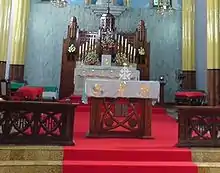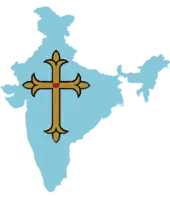Syro-Malabar Catholic Archeparchy of Kottayam
The Knanaya Catholic Archeparchy of Kottayam is a metropolitan archeparchy of the Syro-Malabar Catholic Church in India for Knanaya Catholics. The Knanaya are descendants of Syrian Christians who reportedly migrated to the Malabar coast during the fourth century under the leadership of Thomas of Cana. During the 17th century, they split into Catholic and Orthodox (Jacobite) Churches.
Metropolitan Archdiocese of Kottayam Kottayamensis | |
|---|---|
 Christ the King Knanaya Catholic Cathedral, Kottayam | |
| Location | |
| Country | |
| Ecclesiastical province | Kottayam |
| Metropolitan | Kottayam |
| Headquarters | Christ the King Cathedral, Kottayam |
| Information | |
| Denomination | Knanaya Catholic Church |
| Established | 1923 |
| Cathedral | Christ the King Cathedral |
| Current leadership | |
| Pope | Francis |
| Major Archbishop | Metropolitan and Gate of all India Alencherry Mar Geevarghese metropolitan |
| Metropolitan Archbishop | Mathew Moolakkattu |
| Suffragans | None |
| Auxiliary Bishops | Mar Joseph Pandarassery Geevarghese Mor Aprem |
| Website | |
| kottayamad.org | |
Knanaya History
The Knanaya trace their origins to Thomas of Cana (Knai Thoma), a Syrian merchant who led a group of 72 Jewish-Christian immigrant families, a bishop named Uraha Mar Yausef, and clergymen from Mesopotamia to settle in Cranganore, India in the 4th century (some sources place these events as late as the 9th century).[1][2][3] This may reflect a historical migration of East Syrian Christians to India around this time, which established the region's relationship with the Church of the East.[4] Though the traditional date of arrival for the Knanaya community is 345 C.E. found in the culture and ancient folk songs of the community, several scholars and officials noted throughout the colonial era that this figure may in fact be in reference to a later date between 745-811 C.E.[5]
The Knanaya, also called Southist or Thekkumbhagar in Malayalam, are the descendants of Thomas of Cana and his followers, while the older St. Thomas Christians also called Northist or Vadakkumbhagar, descend from the local Christian body which had been converted by Thomas the Apostle centuries earlier.[6][7][8][9][10][11] The Oxford History of the Christian Church states the following about the division:
"In time, Jewish Christians of the most exclusive communities descended from settlers who accompanied Knayil Thomma (Kanayi) became known as ‘Southists’ (Tekkumbha ̄gar)...They distinguished between themselves and ‘Northists’ (Vatakkumbha ̄gar). The ‘Northists’, on the other hand, claimed direct descent from the very oldest Christians of the country, those who had been won to Christ by the Apostle Thomas himself. They had already long inhabited northern parts of Kodungallur. They had been there even before various waves of newcomers had arrived from the Babylonian or Mesopotamian provinces of Sassanian Persia."[12]
Elements of Thomas of Cana's arrival feature in ancient songs as well as the Thomas of Cana copper plates awarded to his followers by a local Hindu ruler.[13][3][14] These plates are said to have granted Thomas' followers 72 social, economic, and religious rights from Cheraman Perumal, the Chera king.[15][16] The plates were present in Kerala during the time of the Portuguese colonization in the early 17th century, but were lost during Portuguese rule.[17][16] Portuguese Archbishop Francis Ros notes in his 1604 account M.S. ADD 9853 that the plates were taken to Portugal by Franciscans.[18] The Knanaya invoke the plates as evidence of their descent from Thomas of Cana's mission.[19]
Bishops and archbishops
- Mar Mathew Makil (1911-1914)
- Mar Alexander Choolaparampil (1914-1951)
- Mar Thomas Tharayil (1951-1974)
- Mar Kuriakose Kunnacherry (1974-2006)
- Mar Mathew Moolakkattu (2006–present)
Ministry
The archeparchy's ministry focuses on education, jobs, health, social services and the media.
Saints and causes for canonisation
- Servant of God Mathew Makil[20]
- Servant of God Thomas Poothathil[20]
References
- Baum & Winkler 2003, p. 53.
- Karukaparambil 2005, pp. 60.
- Vellian 1990, pp. 25–26.
- Neill 2004, pp. 42–43.
- Kollaparambil 1992, p. 89-98.
- Swiderski 1988a, pp. 74–76.
- Karukaparambil 2005, p. 497.
- Malekandathil 2003, pp. 19–20.
- Thodathil 2001, pp. 111–112.
- Kochadampallil 2019, pp. 24–32.
- Podipara 1971, p. 2.
- Frykenberg 2010, pp. 113.
- Karukaparambil 2005, pp. 460–461.
- Swiderski 1988b, p. 52.
- Swiderski 1988b, pp. 63–64.
- Weil 1982, pp. 175–196.
- Swiderski 1988b, pp. 65–66.
- Kollaparambil 2015, pp. 148–149.
- Swiderski 1988b, pp. 66–67.
- "Saints & Blessed – CCBI". Retrieved 17 October 2019.
